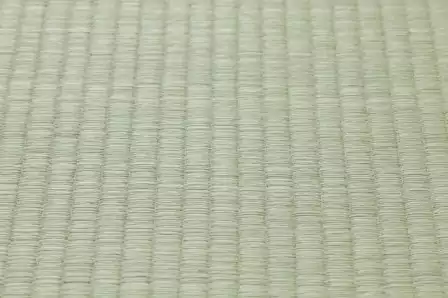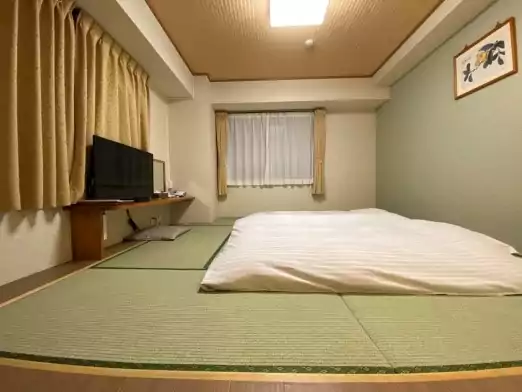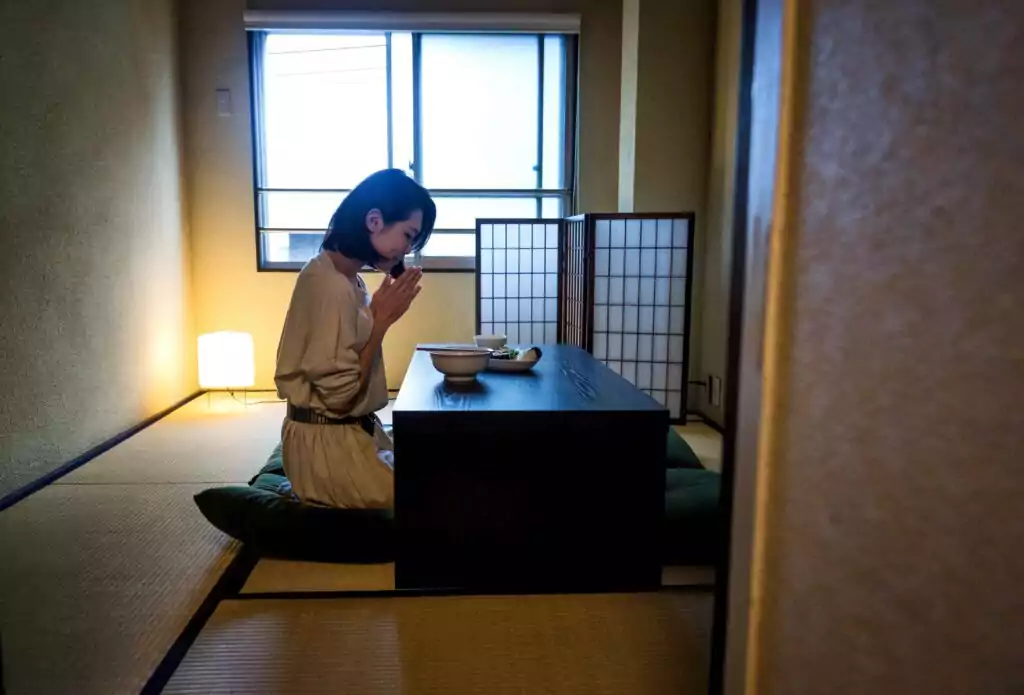The word “tatami” is derived from the Japanese verb, tatamu, meaning “to fold” or “to pile”. This brings about the implication that early tatami mats and squares were thin and could be folded up when not in use or piled up in storage.
Historically, tatami was a luxury item only afforded to those of noble rank. The manufacturing and use of tatami date all the way back to the Jomon Period of 13,000BCE to 300 BC in the form of mushiro, a mat woven from materials composed of straw, sedge, and bamboo fibers.
The tatami in use today has its roots in the Nara Period of 710AD to 794AD and the Heian Period of 794AD to 1185AD where this particular material for flooring was used in sitting and sleeping quarters of a house.
The flooring of traditional Japanese homes did not become fully covered in tatami until the mid-Kamakura Period of 1250AD and again, such a luxury was only limited to the wealthy.
Commoners could only start affording tatami flooring in the mid-Edo Period of 1681AD to 1780AD after a boom in the production of igusa, known as soft rush grass in English during the Azuchi-Momoyama Period of 15673AD to 1603AD. Igusa was the main material for making the surface of tatami mats.
Material
Igusa or rush grass was the chosen material for the production of tatami due to its ability to maintain its firmness when woven around a rice straw core. In Japan, igusa is also known as toshinso.
This natural material was used due to its abundant growth all throughout Japan – igusa can be found from the island of Hokkaido in the north to the islands of Okinawa in the south where they grow in, next to, or near bodies of water such as lakes, marshes, swamps, and rivers.
Igsusa used for the manufacturing of tatami are usually harvested from rice paddy fields in July and this has contributed to why tatami gives off a grassy scent and is tinged green when newly made.
Usage
While tatami has traditionally been the go-to flooring material for many a Japanese home, it’s seen a decline in recent years due to it being difficult and finicky to clean and it being costly to maintain and replace. That being said, it is still common practice for many homes in Japan to have one room with a tatami mat floor and such rooms have come to be known as washitsu or Japanese tatami rooms.

Size
Tatami mats have had such a prevalent presence in homes across Japan that the Japanese real estate industry has taken to using Japanese mat sizes as the standard of unit when measuring the size of a room, apartment, or house. The unit of measurement, known as jo can be found on housing and apartment rental listings – for example, Village House rental properties can start from 10jo or 10 tatami mats in size, which is the average size of a 1K apartment in Japanese cities.
Tatami mat sizes are not universal throughout Japan as they vary by region:
- In Tokyo, tatami come in 0.88m x 1.76m sizes and are known as Edoma Tatami
- In Nagoya, tatami come in 0.99m x 1.91m sizes and are known as Kyoma Tatami
- In Nagoya, tatami come in 0.91m x 1.82m and are known as Aionma Tatami
Multi-Purpose
Tatami is multi-purposeful material to line floors with as they are resilient and act as insulation against heat. Igusa also comes with anti-bacterial properties, with studies on it discovering that it can minimize the spread of illnesses such as E. coli and salmonella.
Tatami flooring can also act as a kind of natural humidifier and dehumidifier – like a sponge, it absorbs moisture when the air is humid and releases moisture when the air is dry. This helps stabilize humidity levels in the house.
The grassy scent and greenish hues of tatami are also suggested to produce a calm, soothing, and safe environment. This has resulted in many tatami rooms being dedicated to kids’ playrooms or nurseries, napping rooms, study rooms, rooms for entertaining guests, a yoga or meditation space, or where the family sets up their religious altar.
If you’re looking to rent a property with Village House and are interested in tatami rooms, feel free to ask any one of the organization’s representatives either online or in person.

Futon
A futon is a traditional Japanese style of bedding that comes in a set that includes a foldable mattress (shikibuton) and a duvet (kakebuton). Futons go in tandem with tatami rooms as it’s tradition to sleep on the floor in Japan.
Futons must be aired and sunned regularly in order to prevent the growth of mold and the presence of mites, which is why it’s a common sight in Japan to see futons being aired over the railings of balconies on sunny days.
As futon mattresses are foldable, they are usually packed away during the day to allow for the tatami room to be used for other purposes; and they are set back out again in the evening after dinner.
Japanese Style Closet
Called oshiire in Japanese, these deep-set closets are used to store futons, blankets, pillows or makura, sitting floor cushions called zabuton, and any other linen or bedding a household might have.
Oshiire is usually one tatami mat in size and divided into two storage spaces – top and bottom – by installing a shelf in the middle. The doors of an oshiire are sliding one and can masquerade as a wall when closed.

Low Tables
Low tables or floor tables are typically used in tatami rooms as it’s common to sit on the floor in Japan. Some may use zabuton or sitting floor cushions instead sitting directly on the tatami mats.
In winter a type of heated low table known as kotatsu is used. A heater is installed underneath the table and covered by a blanket, which is then draped over an individual’s legs to keep them warm and cozy in winter.
Keep Clean
Tatami flooring is notorious for being high maintenance, which has led to its decrease in popularity in recent times. Tatami mats have an average lifespan of 5 to 6 years, after which their color will fade from a grassy greenish tinge to a more yellowish-brown. When tatami flooring starts showing signs of wear and tear, viable options include flipping them over or replacing them.
Tatami flooring can also be tricky to clean as igusa will pick up and absorb things like dirt and liquid. This means that in order to keep it clean, stain-free, and pest-free, tatami rooms need to be cleaned on a regular basis.
Tatami material can also be sensitive to humidity, resulting in the growth of mold if one does not adhere to a regular cleaning schedule.
To clean a tatami floor, one can use a vacuum with a dedicated tatami attachment or purchase a tatami-specific mop. The other option is to manually clean the tatami floor with a dry cloth. It’s important to note that when vacuuming, mopping, or wiping down tatami, one should do so in the direction of the rush grass in order to minimize and avoid damage to the material.
Related articles:
- Caring for Your Tatami: A Beginner’s Guide
- How to Live Comfortably in an Old Apartment
- How to Choose the Perfect Lighting for Your Home
- Making a “Zen” Modern Japanese-Style Room
- Curious about Renting an Apartment with Japanese-style rooms? The Pros and Cons You Want to Know!



